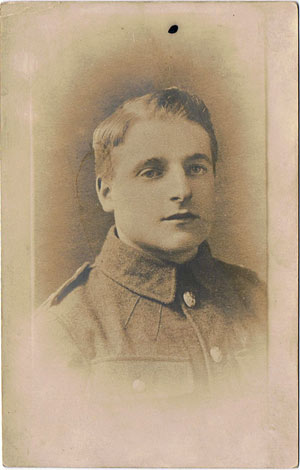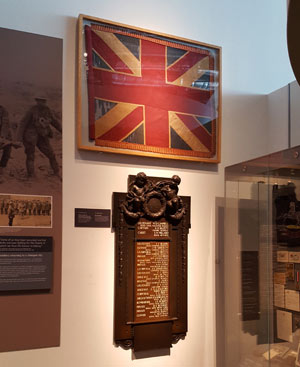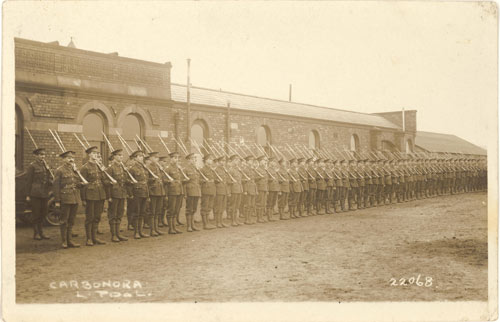
Portrait photograph postcard of Private Harry Grace, King's Regiment. Written on the reverse, 'Signaller Harry Grace, Killed in France 1st July 1916, 18th Service K.L.R. "Pals" (2nd Batt).' Private Harry Grace was a scoutmaster and prominent member of Richmond Baptist Youth Group. He was 19 when he was killed by a shell at the Somme.
One hundred years ago this week, on 1 July 1916, British Forces suffered their worst casualties ever in one single day. Communities all over Britain will come together on Friday 1 July to commemorate the anniversary of what is often called, ‘the bloodiest day in British military history’. At the Museum of Liverpool our latest exhibition
First World War: Charity and Liverpool’s Home Front, looks at some of the organisations that were instrumental in helping both the casualties who came home from the war, and also the families of the men who did not.
That first day of the Somme saw 19,240 British men killed in action, a further 40,000 were wounded or taken prisoner. The British front line stretched from Gommecourt to Maricourt - around 18 miles of trenches. South of Maricourt, the French Army held the line. The battle was a tactical one, meant to divert German troops from a much larger battle, being fought against the French further east at Verdun.
A week-long artillery bombardment would effectively destroy the German forces in their own trenches. It would devastate their defences and more importantly, cut the barbed wire protecting the trenches from no-mans-land. The bombardment would continue raining shells on the German front line for a few minutes after zero-hour, giving any surviving German troops little time to regroup and launch a defence. British troops could then cross no-mans-land and easily capture German positions. That was the plan...
The reality was that the Germans had held some sectors of the Somme from as early as 1914. They’d had a long time to prepare. Their dug-outs were much deeper than Allied commanders expected. Their wire defences were also much wider. The British did not have enough heavy artillery shells to do the extensive damage needed, either to the defences or the wire. At 7.30am on 1 July, whistles blew and along the British front line, men moved forward. Concerned that inexperienced troops would struggle with evasive tactics, the men had been ordered by commanders to walk forward, in lines. As soon as the bombardment stopped, German troops were able to rush up out of their dug-outs and were ready with their machine guns, as the British troops advanced towards them. The effects were catastrophic and entire companies of men were mown down.

The Colour flag for the 18th (Pals) Battalion is one of the King's Regiment items from the First World War on display at the Museum of Liverpool.
When we talk of the Battle of the Somme, that first day in July immediately comes to mind, but many people are surprised to learn that the fight in the Somme Valley was actually a series of Battles that lasted 141 days until 18 November.
The Battle of the Somme would continue and for Liverpool the big ‘Somme story’ was yet to come. Every day throughout the centenary of the Somme we will be tweeting, to remember some of the ‘Kingos’ - members of the
King's Regiment -who lost their lives.
Watch out for some more blogs, starting tomorrow, looking at how the King’s Regiment was involved in key battles in the Somme Valley.
I will also be giving a
free talk about the Battle of the Somme at 2pm tomorrow, Friday 1 July, at the Museum of Liverpool.

Liverpool Pals lined up at Prescot Barracks

 Portrait photograph postcard of Private Harry Grace, King's Regiment. Written on the reverse, 'Signaller Harry Grace, Killed in France 1st July 1916, 18th Service K.L.R. "Pals" (2nd Batt).' Private Harry Grace was a scoutmaster and prominent member of Richmond Baptist Youth Group. He was 19 when he was killed by a shell at the Somme.
One hundred years ago this week, on 1 July 1916, British Forces suffered their worst casualties ever in one single day. Communities all over Britain will come together on Friday 1 July to commemorate the anniversary of what is often called, ‘the bloodiest day in British military history’. At the Museum of Liverpool our latest exhibition First World War: Charity and Liverpool’s Home Front, looks at some of the organisations that were instrumental in helping both the casualties who came home from the war, and also the families of the men who did not.
That first day of the Somme saw 19,240 British men killed in action, a further 40,000 were wounded or taken prisoner. The British front line stretched from Gommecourt to Maricourt - around 18 miles of trenches. South of Maricourt, the French Army held the line. The battle was a tactical one, meant to divert German troops from a much larger battle, being fought against the French further east at Verdun.
A week-long artillery bombardment would effectively destroy the German forces in their own trenches. It would devastate their defences and more importantly, cut the barbed wire protecting the trenches from no-mans-land. The bombardment would continue raining shells on the German front line for a few minutes after zero-hour, giving any surviving German troops little time to regroup and launch a defence. British troops could then cross no-mans-land and easily capture German positions. That was the plan...
The reality was that the Germans had held some sectors of the Somme from as early as 1914. They’d had a long time to prepare. Their dug-outs were much deeper than Allied commanders expected. Their wire defences were also much wider. The British did not have enough heavy artillery shells to do the extensive damage needed, either to the defences or the wire. At 7.30am on 1 July, whistles blew and along the British front line, men moved forward. Concerned that inexperienced troops would struggle with evasive tactics, the men had been ordered by commanders to walk forward, in lines. As soon as the bombardment stopped, German troops were able to rush up out of their dug-outs and were ready with their machine guns, as the British troops advanced towards them. The effects were catastrophic and entire companies of men were mown down.
Portrait photograph postcard of Private Harry Grace, King's Regiment. Written on the reverse, 'Signaller Harry Grace, Killed in France 1st July 1916, 18th Service K.L.R. "Pals" (2nd Batt).' Private Harry Grace was a scoutmaster and prominent member of Richmond Baptist Youth Group. He was 19 when he was killed by a shell at the Somme.
One hundred years ago this week, on 1 July 1916, British Forces suffered their worst casualties ever in one single day. Communities all over Britain will come together on Friday 1 July to commemorate the anniversary of what is often called, ‘the bloodiest day in British military history’. At the Museum of Liverpool our latest exhibition First World War: Charity and Liverpool’s Home Front, looks at some of the organisations that were instrumental in helping both the casualties who came home from the war, and also the families of the men who did not.
That first day of the Somme saw 19,240 British men killed in action, a further 40,000 were wounded or taken prisoner. The British front line stretched from Gommecourt to Maricourt - around 18 miles of trenches. South of Maricourt, the French Army held the line. The battle was a tactical one, meant to divert German troops from a much larger battle, being fought against the French further east at Verdun.
A week-long artillery bombardment would effectively destroy the German forces in their own trenches. It would devastate their defences and more importantly, cut the barbed wire protecting the trenches from no-mans-land. The bombardment would continue raining shells on the German front line for a few minutes after zero-hour, giving any surviving German troops little time to regroup and launch a defence. British troops could then cross no-mans-land and easily capture German positions. That was the plan...
The reality was that the Germans had held some sectors of the Somme from as early as 1914. They’d had a long time to prepare. Their dug-outs were much deeper than Allied commanders expected. Their wire defences were also much wider. The British did not have enough heavy artillery shells to do the extensive damage needed, either to the defences or the wire. At 7.30am on 1 July, whistles blew and along the British front line, men moved forward. Concerned that inexperienced troops would struggle with evasive tactics, the men had been ordered by commanders to walk forward, in lines. As soon as the bombardment stopped, German troops were able to rush up out of their dug-outs and were ready with their machine guns, as the British troops advanced towards them. The effects were catastrophic and entire companies of men were mown down.
 The Colour flag for the 18th (Pals) Battalion is one of the King's Regiment items from the First World War on display at the Museum of Liverpool.
When we talk of the Battle of the Somme, that first day in July immediately comes to mind, but many people are surprised to learn that the fight in the Somme Valley was actually a series of Battles that lasted 141 days until 18 November.
The Battle of the Somme would continue and for Liverpool the big ‘Somme story’ was yet to come. Every day throughout the centenary of the Somme we will be tweeting, to remember some of the ‘Kingos’ - members of the King's Regiment -who lost their lives.
Watch out for some more blogs, starting tomorrow, looking at how the King’s Regiment was involved in key battles in the Somme Valley.
I will also be giving a free talk about the Battle of the Somme at 2pm tomorrow, Friday 1 July, at the Museum of Liverpool.
The Colour flag for the 18th (Pals) Battalion is one of the King's Regiment items from the First World War on display at the Museum of Liverpool.
When we talk of the Battle of the Somme, that first day in July immediately comes to mind, but many people are surprised to learn that the fight in the Somme Valley was actually a series of Battles that lasted 141 days until 18 November.
The Battle of the Somme would continue and for Liverpool the big ‘Somme story’ was yet to come. Every day throughout the centenary of the Somme we will be tweeting, to remember some of the ‘Kingos’ - members of the King's Regiment -who lost their lives.
Watch out for some more blogs, starting tomorrow, looking at how the King’s Regiment was involved in key battles in the Somme Valley.
I will also be giving a free talk about the Battle of the Somme at 2pm tomorrow, Friday 1 July, at the Museum of Liverpool.
 Liverpool Pals lined up at Prescot Barracks
Liverpool Pals lined up at Prescot Barracks
